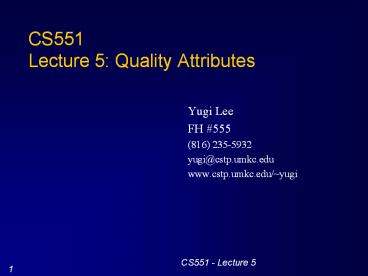CS551 Lecture 5: Quality Attributes - PowerPoint PPT Presentation
1 / 16
Title:
CS551 Lecture 5: Quality Attributes
Description:
Does it make efficient use of resources? Is it scalable? ... Integrability: The ability to make the separately developed components of the ... – PowerPoint PPT presentation
Number of Views:197
Avg rating:3.0/5.0
Title: CS551 Lecture 5: Quality Attributes
1
CS551Lecture 5 Quality Attributes
- Yugi Lee
- FH 555
- (816) 235-5932
- yugi_at_cstp.umkc.edu
- www.cstp.umkc.edu/yugi
2
Classifications of Qualities
- Functional requirements - visible to a systems
end- user - Non-functional requirements - visible only to a
systems developers - Business quality
- Product vs. Process
- Qualities of a process can impact the qualities
of a product - Product can take on different meanings for
different stakeholders - Quality attributes can be prioritized according
to the stakeholders needs
3
External Quality Attributes
- Functional Requirements Performance, security,
availability, functionality, usability - How well does the system, during execution
satisfy its behavioral requirement? - Does it provide the required result?
- Does it provide them in a timely enough manner?
- Are the results correct or within specified
accuracy and stability tolerances? - Does the system function as desired when
connected to other systems?
4
Internal Quality Attributes
- Non-functional Requirments
- Modifiability, scalability, portability,
reusability, integrability, testability
(verifiability), interoperability - How easy is the system to integrate, test and
modify? - Business Qualities
- Time to market, Cost, Projected lifetime of the
system, Targeted market, Rollout schedule,
Extensive use of legacy systems - How expensive was it to develop?
- What was its time to market?
5
Software Qualities
- Correctness/Verifiability
- Reliability/Availability
- Robustness
- Performance
- Security
- Maintainability/Modifiability
- Reusability/Integrability
- Understandability/Usability/User Friendliness
- Interoperability/Portability
- Productivity
- Timeliness/Visibility
6
Correctness Verifiability
- Correctness
- A system is functionally correct
- if it behaves according to its functional
requirements specifications - Correctness asserts an equivalence between the
software and its specifications - Assessment Testing and Verification (program
proofs) - Verifiability
- Can properties of the system be verified?
- Typically an internal quality
7
Reliability Availability
- Reliability A system can be reliable but not
correct - e. g. the fault is not serious in nature and the
user can continue to get work done in its
presence - Engineering products are expected to be
reliable with software, users expect bugs! - Availability how quickly the system is able to
resume operation in the event of failure.
8
Security
- The systems ability
- to resist unauthorized attempts at usage and
denial of service - while still providing it services to legitimate
user.
9
Robustness
- How well does a system behave in situations not
specified by its requirements? - Examples
- incorrect input, hardware failure, loss of power
- Related to correctness
- response specified
- implementation must handle to be correct
- response not specified gt robustness involved
10
Performance
- In SE, performance is equated with efficiency
- How quickly does it perform its operations?
- Does it make efficient use of resources?
- Is it scalable?
- The time required to respond to stimuli (events)
or the number of events processed in some
interval of time.
11
Modifiability Maintainability
- Modifiability
- The ability to make changes quick and cost
effectively - A function of locality of any change
- Most closely aligned to the architecture of a
system - Maintainability
- Corrective (software repair), enhancement
(software update), Perfective (the effective of
the product) , and Adaptive (changes in
environment) - Related Repairability and Evolvability
12
Reusability Integrability
- Reusability Software components, people,
requirements can be reused again in future
applications. - SE needs to make reuse standard practice
- Why? Its standard practice in all engineering
disciplines! - Integrability The ability to make the separately
developed components of the system work correctly
together.
13
Portability Interoperability
- Portability
- The ability to run the same system in multiple
contexts (typically hardware/ OS combinations) - Interoperability
- Can a system coexist and cooperate with other
systems? - Again, present in other engineering disciplines
14
Understandability Usability User Friendliness
- Understandability
- How well do developers understand a system they
have produced? - supports evolvability and understandability
- Usability The right information is available to
the user at the right time - User Friendliness Human- Computer Interaction
- Related Human Factors, Cognitive Science
15
Productivity
- The efficiency of a development process
- An efficient process can produce a product faster
and with higher quality - Can parts of it be automated?
- Standard processes?
- Software Life Cycles
- Capability Maturity Model
- Measure everything!
- Use the results to improve the process the next
time
16
Visibility Timeliness
- Visibility
- A process is visible if all of its results and
current status are documented clearly to internal
and external viewers - Timeliness
- The ability to deliver a system on- time
- requires careful scheduling, accurate estimates
and visible milestones































